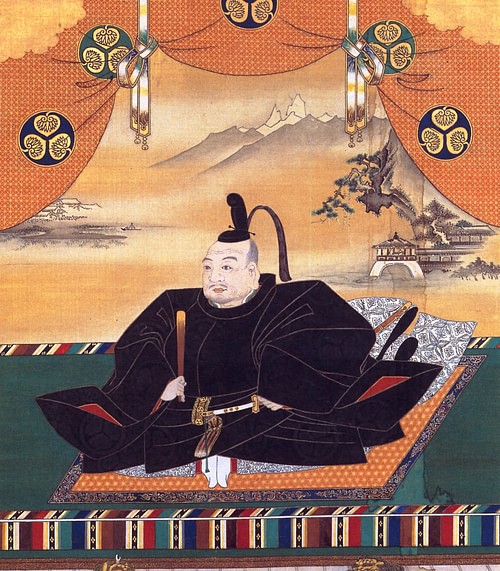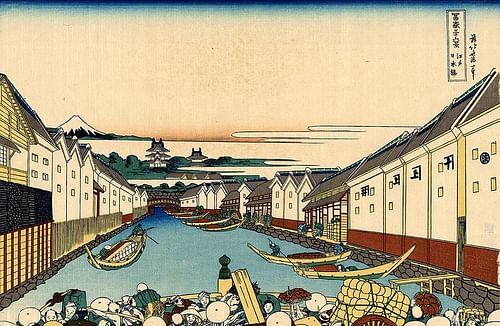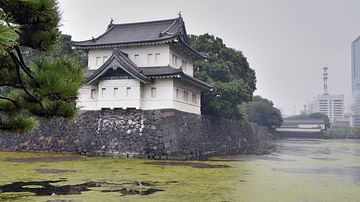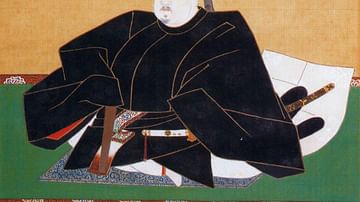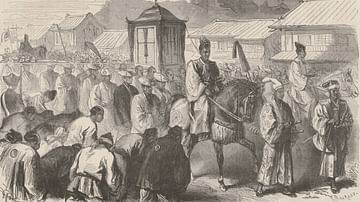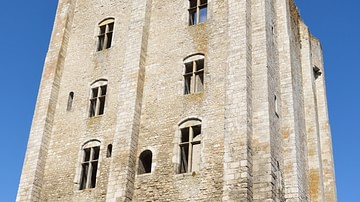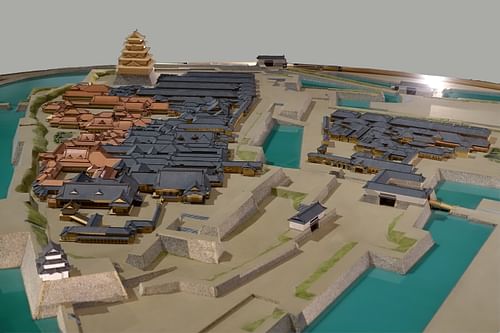
Edo Castle was a large castle built by the Tokugawa family in 17th-century Japan. It served as their seat of government for more than 260 years. After the Meiji Restoration of 1868, Edo became the capital of Japan and was renamed Tokyo. Edo Castle became the residence of the imperial family and was renamed the Imperial Palace.
Background
At the end of the 15th century, the central government in Japan collapsed and the country descended into civil war. The period from 1467 until 1573 is referred to as the Sengoku or Warring States period. During the Sengoku period, rival warlords, called sengoku daimyo by modern historians, competed for power and land. In the 1560s, one of these daimyo called Oda Nobunaga (1534-1582), managed to reunify large parts of Japan. In 1582, however, he was assassinated, and the task of reunifying the rest of Japan fell to his successor, Toyotomi Hideyoshi (1537-1598).
In 1590, Hideyoshi launched a campaign against a rival daimyo family called the Go-Hojo whose base was near the modern city of Odawara in eastern Japan. After the campaign was successfully completed, Hideyoshi offered to reward Tokugawa Ieyasu (1543-1616), one of his powerful subordinates, with all the land in the Kanto region. In exchange, however, Ieyasu would have to give up the land he already controlled in central Japan. On the one hand, this was a reward because it would give Ieyasu control over more land, but on the other hand, it would weaken his position because the area was further from the capital of Kyoto and he had no traditional ties there. If he refused, it would also mean war with Hideyoshi.
The Village of Edo
Ieyasu decided to accept, and in 1590, he officially visited Edo, the site he had chosen for his headquarters. Edo had once been the home of a warrior called Ota Dokan (1432-1486) and the remains of his residence, Chiyoda Castle, were still there. Apart from that, it was just a tiny fishing village. In the early 1590s, Ieyasu did a little work to develop Edo but mostly he devoted his energies to building up his power base. In 1598, Hideyoshi died, and in the struggle for power that followed, Ieyasu emerged as the strongest daimyo in Japan. In 1600, in the Battle of Sekigahara, he led a coalition of daimyo armies from eastern Japan to victory against a similar coalition of armies from western Japan who supported Hideyoshi's son. In 1603, he had the emperor appoint him as shogun, and this allowed him to establish his own government. At this point, Ieyasu had to make another choice, either move to the capital Kyoto as earlier shoguns had done or stay in Edo and rule from there. He chose to stay in Edo.
Building Edo Castle
Having decided to rule from Edo, Ieyasu set about building a huge castle that would serve as his seat of government. In doing this, he was following a precedent that had been set by Oda Nobunaga, who built Azuchi Castle, and Toyotomi Hideyoshi, who had built castles in both Osaka and near Kyoto. Under the political settlement that followed the Battle of Sekigahara, the Tokugawa shogunate controlled about 30% of the land in Japan, and the rest was left in the hands of other daimyo families. Ieyasu did not trust these daimyo, and he implemented various strategies to control and weaken them.
One of these was to order them to carry out large building tasks that would use up their resources. He used this method to build Edo Castle. Daimyo were ordered to provide labour and materials in proportion to the size of their own revenue. As a result, masses of stone, timber and other goods were shipped to Edo from all around Japan.
The Layout of Edo Castle
The initial layout of the castle was based on the principles of geomancy, sometimes called feng shui. These principles required that there be a river to the east, a lake or ocean to the south, a road on the west and a mountain to the north. A location that roughly met these requirements was found, and work was begun on the castle. After Ieyasu, became shogun these plans had to be altered in order to make the castle much bigger. Ieyasu died in 1616, but the work was continued by his successors and finally finished in 1639.
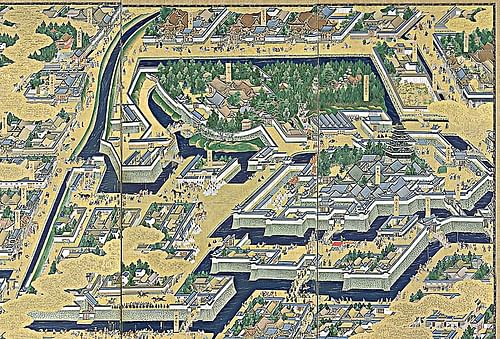
Edo Castle was not only large but it was also elaborate. The grounds were divided into various enclosures surrounded by moats and large stonewalls. On these walls, various towers and watchhouses were built. Each enclosure could be reached via wooden bridges with gates on either side. In the central enclosure were the main castle keep and a series of single-story buildings that served as the home of the shogun's family and the headquarters of the government. The main keep was 44 metres (144 ft) high and had five stories on the outside and seven on the inside. Fortunately, maps and other illustrations have survived from this period so we know what the castle looked like.
Moats, Canals, Roads, & Bridges
Building a castle of this size required extensive earthworks. In the course of construction, earth was removed from the Kanda Hill area to the north and used to reclaim land in the shallow waters of Edo Bay at the foot of the castle. Taking advantage of topographical features such as rivers, valleys and hills, inner and outer moats were dug that extended outward from the castle in a clockwise spiral. The perimeter of the inner moat was around 5 kilometres (3 mi) and the outer one was around 16 kilometres (10 mi). A canal, called Dosan-bori, was dug linking the castle to Edo Bay. This canal was vital for transporting stone, timber, and other materials necessary for the construction of the castle. Later more canals were dug and these were one of the major features of Edo, which was oriented around water.
The main river in Edo was called the Sumida, and its course was redirected to facilitate the construction of the castle and the town. Another important river was called the Edo River, and in 1603, a bridge was built over it called Edobashi (bashi means "bridge" in Japanese). The name was later changed to Nihonbashi, which means "the bridge of Japan". This was used as the starting point for five major roads that linked Edo with other parts of the country. The most significant of these was the Tokaido, a road that ran along the Pacific coast as far as Kyoto. Along these roads, 'post stations' were established where people could get food and accommodation.
Yamanote & Shitamachi
One mechanism the Tokugawa used to control daimyo was to have them carry out duties in Edo, and that required them to maintain a residence there. In 1635 this practice was formalised in the system of alternate attendance (sankin kotai). Under this system, daimyo had to spend alternate years in Edo and in their own territories. Their families had to live in Edo permanently where they were, in effect, hostages. Daimyo were required to build mansions in Edo the size of which was determined by their status. The mansions of the daimyo were located on the higher part of the city around the castle. This area is referred to as yamanote, which means "hilly land". In contrast to this, ordinary people lived in the lower part of the city near the Sumida River. That part of the city was called shitamachi, which literally means "downtown". The heart of the shitamachi district was Nihonbashi, which developed as a centre of trade and commerce.
This distinction between yamanote and shitamachi is one that still exists today. The circular rail line that runs around central Tokyo is called the Yamanote Line. In movies and TV shows, the idea of shitamachi is often used as a trope to indicate the traditional working-class values of old Edo.
The Danger of Fire
The population of Edo grew rapidly because of the influx of daimyo and their retainers as well as the ordinary people who provided services to them. By 1650, it had reached about 300,000 people. Because houses were built very close together and were mainly made of wood, fire was always a great danger. It was so common that it was referred to as the 'flower of Edo'. In 1657, a huge inferno engulfed the whole city, which is said to have killed around 100,000 people. Many of the castle buildings, including the main keep, burnt down, along with the mansions of the daimyo. Many of the castle buildings were replaced, but it was decided that it was too expensive to rebuild the main keep at a time when it no longer served any purpose. In the rest of the city, additional steps were taken to prevent another conflagration, including putting in wider fire breaks. Despite the high death toll, the population of Edo continued to grow, and by about 1720, it had reached one million, making it the largest city in the world at the time.
Temples, Theatres, & Brothels
Religion has always been an important aspect of life in Japan and Shinto shrines and Buddhist temples are found all over the country. The oldest Buddhist temple in Edo was called Sensoji and is said to date back to 628. Soon after Ieyasu entered Edo, he designated it as a tutelary temple for the Tokugawa family. Sensoji is located in a place called Asakusa near the Sumida River. Now it is a popular tourist destination, and the area around the temple is promoted as a place where you can experience the atmosphere of old Edo. While it is rather touristy, there are lots of interesting things to see there. Nearby, on the opposite side of the Sumida River, is Ryogoku where the National Sumo Stadium and the Edo-Tokyo Museum are located.
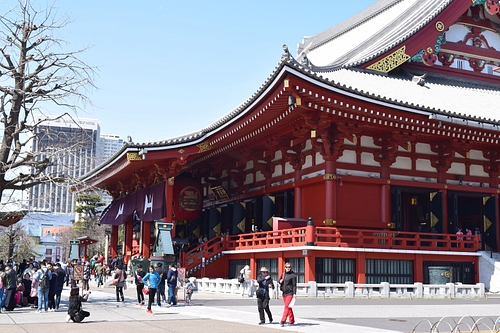
In the early years of the 17th century, while the castle was still being constructed, men outnumbered women in Edo by two to one. As a result, prostitution was commonplace. At first, brothels were spread about the town in various places. In order to maintain social order, however, the government decided to confine them to specific areas. In English, these are usually referred to as the 'pleasure quarters'. In Edo, the largest of these was called Yoshiwara. At first, it was located near Nihonbashi, but as the city grew, it was ordered to move to an area north of Asakusa.
Another popular diversion in the Edo period was attending the theatre. While the puppet theatre and kabuki mainly developed in Kyoto and Osaka, theatres were also built in Edo. Together with the 'pleasure quarters, Japanese theatre was referred to as the ukiyo, the 'floating world', by which was meant the world of transient enjoyment.
Pictures of the Floating World
Ukiyo-e, ("pictures of the floating world"), which are known in English as woodblock prints were one the most distinctive art forms to appear in the Edo period. Initially, they were black-and-white book illustrations, but as the techniques for printing in colour developed, they came to be appreciated in their own right. In addition to erotica, popular topics were the courtesans and kabuki actors who frequented the 'floating world'. Later still, prints depicting landscapes appeared. As travel became popular, guidebooks would also include prints. Prints of famous places were sold separately as souvenirs. Two of the best-known landscape artists are Katsushika Hokusai (1760-1849) and Utagawa Hiroshige (1797-1858). Their pictures are highly stylised but they give us some idea of what Edo looked like at the time.
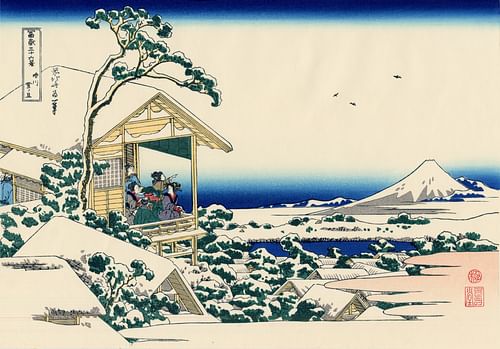
Edo Castle Becomes the Imperial Palace
In 1868, the Tokugawa were overthrown in an event known as the Meiji Restoration. This involved a short war between supporters of the Tokugawa and those that wanted to restore the imperial family to power. As a result of negotiations between the two sides, however, the Tokugawa agreed to surrender Edo Castle without a fight. As a result, no damage was done to the city. Edo then became the capital of Japan, and it was renamed Tokyo which means "eastern capital". The imperial family took up residence in Edo Castle, and the name was changed to the Imperial Palace (Kokyo). The present grounds of the Imperial Palace are only about one-third the size of those of the original castle. Still, the wide moat and huge stonewalls are a reminder of how big Edo Castle must once have been.
